by Winding Pathways | Sep 5, 2019 | Nature, Pests
Sometimes the best of intentions turn into a nightmare. A plant down the road from Winding Pathways is proof.
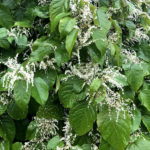
Beware the beauty of Japanese Knotweed.
In the 1840s Philipp Franz von Siebold was in Nagasaki, Japan, and believed a common native plant was so useful and interesting that it should be shared with the world. He shipped cuttings to the Netherlands. The plant thrived and soon gardeners were planting it because of its attractive reddish young leaves, hollow stems somewhat like bamboo, and its showy white flowers that bloom in September. Young shoots are even edible somewhat like asparagus in early spring.
Von Siebold thought he was doing a good thing by bringing this plant to Europe, but soon gardeners realized it was a rapidly spreading monster that crowded out more valuable vegetation. The World Conservation Union calls it one of the worst of the invasives.
It arrived in the United States in the late 1800s as a desirable garden plant, and soon it was found wild in at least 39 states. It’s an invasive problem in England, New Zealand, the United States, and many other countries.
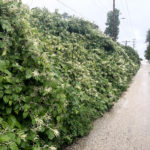
Knotweed forms dense patches and spreads with rhizomes.
Japanese knotweed forms colonies so dense they crowd out all other plants. Rhizomes spread horizontally under the soil surface and soon new plants pop up from them. Early spring shoots have a reddish cast. Leaves are triangular, and the plants quickly grow to four or five feet tall. They are amazingly abundant along streams and lakes. In Iowa, we often see them along roads. They are especially easy to spot when their showy white blooms form in late August and continue into September.
Knotweed is an edible plant in early spring, but anyone with a garden or natural area should be cautious about bringing it home. Drop a node on the ground and it will soon sprout and grow and grow and spread and spread.
Once established Knotweed is hard to control, although continuous mowing should knock it back. It’s something to keep out of the yard, and so far, we’ve been successful at Winding Pathways.
by Winding Pathways | Aug 29, 2019 | Birds, Bugs, Flowers/Grasses, Garden/Yard, Nature
On a sunny, warm, late summer day we watched countless bees and butterflies foraging on prairie plants, hummingbirds sipping nectar from Cardinal flowers, and small birds pausing to drink water on the cup plants. That evening, bats swooped across the sky as clouds gathered. Then, came the downpour.
So, we wondered, where do birds and bees and bats go during storms or just to rest? A bit of Internet searching yielded some fascinating information.
Bees
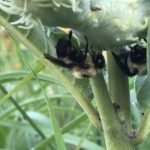
seeking shelter from the rain
Bees are active in the day and need sleep just like humans do. How they sleep is quite different. Bees and many insects do not have eyelids. They relax the body and antennae and sometimes fall over. Sometimes, the other bees in a honeybee colony prop up the “sleeping” bee. As we see in this video, and similar to human babies, they sleep in shorter bursts. This sleep helps their memory. Remember, bees, especially honeybees explore new foraging spots, return to the hive, communicate through a “dance” telling other bees where the source of nectar is. As with people, good sleep helps them perform better. Look for bees on the underside of leaves and grass blades after a rain or in the early morning.
Butterflies
Butterflies also seek shelter on the underside of leaves or grass blades. This vegetation protects them from furious winds and debilitating raindrops. Think about it! How delicate a butterfly’s wings are and how a large raindrop can punish it. A Scientific American article gave a great comparison to us humans – being whacked by a water balloon twice the mass of a bowling ball!
Birds and Bats

One hummingbird fell into a torpor on the feeder!
To rest, Hummingbirds go into torpor – a sleep-like state where the body temperature drops to conserve energy. They sometimes hang upside down as we see in this video. When the temperatures rise, they “wake up”. They can fly in moderate rains.
Some larger birds, like turkeys, actually come out in rainstorms and forage on insects that are slowed down by the cooler temperatures. At night, turkeys roost in trees. Watching them navigate through dense forests into the tops of sturdy trees is amazing.
Nighthawks, along with their nocturnal companions bats, find daytime shelter on tree branches. Bats tuck under tree bark flaps, in crevices and caves, and enter tiny cracks in homes making attics a cozy den.
Next time you are out and about, look carefully on undersides of leaves and grass blades, study branches of trees for unusual shapes that might be a roosting bird, and notice animals out and about at different times of the day and in different weather.
by Winding Pathways | Jul 25, 2019 | Gazette Features, Nature, Travel/Columns

Capturing the sunset.
Iowa may be the flyover region of the country and people are missing out on grand adventures, pastoral scenes and tasty home-cooked meals. Come along with us as we explore the Driftless Area of Iowa, Minnesota, Wisconsin and Illinois. This invitation especially includes the Presidential Candidates! Get out and see our country! Read about our adventures in the Cedar Rapids Gazette.
by Winding Pathways | Jul 18, 2019 | 1080 Labyrinth Blog, Labyrinths, Nature, Reflections/Profiles, Wonderment
Lights twinkled in the yard and labyrinth. The faint perfume of milkweed wafted up in the still, hot, early summer air. Calling. Calling.
We had arrived home at dusk after a long journey home from the East. Still in “travel mode” we unpacked the car and put away most of our trip supplies. As darkness wrapped around us, we let ourselves release the tension that builds up from high-speed driving through eight states and visiting with numerous family and friends in four different states.
So, in the dark, with stars guiding me, fireflies dancing around me and the soft aroma of milkweed calming me, I walked the Phoenix Harmony Labyrinth.
How can I explain the grounding, settling in and the sense of “coming home” that flowed into and through me? I kept saying over and over, “Thank you, thank you, thank you.”
To the rental car for its comfort. For safe travels by car, on foot, and in buses and subways. For great meals with friends and family. For respites in unexpected places. Fr color. For quiet. For seeing different parts of the land and meeting different people. For perspectives.
While my words are weak in conveying my experience that evening, I trust that some readers have had a similar experience the memory of which lingers in their soul. A memory they can return to time and again to calm, soothe, and refresh them.
-

-
The warm summer air brings out the subtle fragrance of the milkweed.
-

-
Summer’s palette of color.
by Winding Pathways | Jul 11, 2019 | (Sub)Urban Homesteading, Garden/Yard, Trees
Early one May afternoon we arrived home, glanced into the woods past our property, and were astonished to see an enormous red oak on the ground. The tree looked healthy, solid, and unlikely to topple, but it fell on a clear calm day. On its way down the old veteran broke two younger trees growing nearby.
A week or so later we woke to an enormous crash. It was pitch dark so we were only able to search around with a flashlight to learn that nothing had hit our house. The next morning, we discovered a giant elm prostate on the ground about 150 feet from our bedroom on a neighbor’s property. Like the oak, it fell when it was calm. Unlike the oak, the elm had been dead for years and many mushrooms were growing from its trunk.
We enjoy a huge diversity of birds and other wildlife in our yard, in part because we adjoin Faulkes Heritage Woods, a 110 wild forest protected by a conservation easement. The Woods have not been logged for over a century, so many enormous oaks, hickories, and maples live there. Many are dead or in decline, but that’s great for wildlife.

Dead trees provide food and nesting sites
Of all landscape features few are as valuable to as many wildlife species as an old dead tree. Nearly as soon as a tree dies insects, bacteria, and fungus begin the long process of recycling wood and bark back into humus. Woodpeckers drill into dead trees to extract tasty insects and carve out nesting cavities. Often their old cavities are used by chickadees, wrens, and many other cavity nesters. Dead trees are favored perching sites for raptors, perhaps because they are leafless, so the sharp-eyed birds can spot prey on the ground.
We let dead trees stand on our property, as long as they are far enough away from the house so they can’t cause damage or injure someone when they crash down.
Are Dead Trees Dangerous
We’ve been in the right place at just the right time to see big trees fall. Usually, there’s a crack or two before a giant tree crashes down with lightning speed. If someone were underneath it then it would be hard to run fast enough to escape injury.
The odds of a person being hit by a falling tree while walking along a trail are infinitesimally small. It almost never happens. Most injuries and fatalities occur when people camp, picnic, or sit under a tree. The risk comes because they are under the tree for hours while sleeping or in a position where they can’t run and escape quickly.

Look up when placing your tent near trees.
Before setting up a tent always look up and never pitch it under a weak or dead tree that could fall in the night.
How to Tell If A Tree Is Likely to Fall

It’s a wonder this tree stood as long as it did.
Determining if a tree is likely to fall isn’t always easy. Sometimes seemingly healthy strong trees fall over, but often one gives notice that it is in decline and weakening. Here are visible signs that a tree is vulnerable to falling:
- It’s dead. No leaves. Branches occasionally dropping off. Bark sheathing off.
- It’s alive but increasingly branches are dying and are bare of leaves.
- Mushrooms are growing from the wood.
- Little piles of sawdust at the base show that insects or woodpeckers have been at work.
- It’s old. As trees age, they stiffen and eventually, their wood weakens. Young healthy smaller trees are more flexible and bend back and forth in heavy wind without damage. Wind can crack the wood of old stiff trees.
- All trees eventually fall down but some have notoriously weak wood that breaks easily. Silver maples, black locust, and Siberian Elms often shed big limbs or break during storms.
Should I Have A Tree Taken Down?

Log ready to be bucked up to firewood.
Losing a beautiful old tree is painful, but there is a time when the tree should be removed to prevent an injury, death, or damage. At Winding Pathways, we let even old weak trees stand as long as they are well away from the house or places where sit. But if the tree could fall and hit a parked car, house or barn we call a tree service and have it repurposed into firewood.
This Youtube video provides an excellent overview of live and dead trees, saving or cutting the appropriate trees. My Woodlot.
by Winding Pathways | Jul 4, 2019 | Garden/Yard, Garden/Yard, Mammals, Nature
People are surrounded by synanthropes. It’s a long and obscure word that is descriptive of hundreds of wild plants and animals.
A synanthropic species is one that benefits from and lives close to people. Essentially, if people disappeared these plants and animals would struggle to survive and, perhaps, disappear themselves. They need us! Other species are semi-synanthropic and live close to people or benefit from human action but might live in lower numbers in wild places.
At Winding Pathways, we strive to restore species native to our area of Iowa. We’ve had success, but we’re still surrounded by synanthropes that require our presence. Fortunately, we don’t have Norway rats or rock pigeons but these and other species are common in the biggest cities worldwide. They are wildly successful in the grittiest urban areas.
House mouse and Norway rat
House fly
House Sparrow, American Robin, House Finch, House Wren, Rock Pigeon, Canada Goose, and Ringneck Pheasant
Raccoon, Opossum, Woodchuck
Plants:
Dandelion, Purslane, Lambs quarters, Kentucky bluegrass, And many common weeds.
We encourage everyone to look around and notice plants and animals in their homes and yards and learn whether they’d be there without human presence. Expand our list! If they would disappear should the yard be a virgin wilderness and people were absent, then they are synanthropes.
-
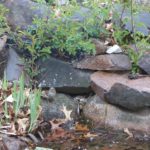
-
English Sparrows thrive around people.
-
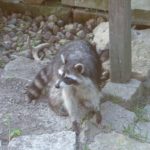
-
Raccoons forage mostly at night.
-

-
Pigeons depend on people to thrive.














